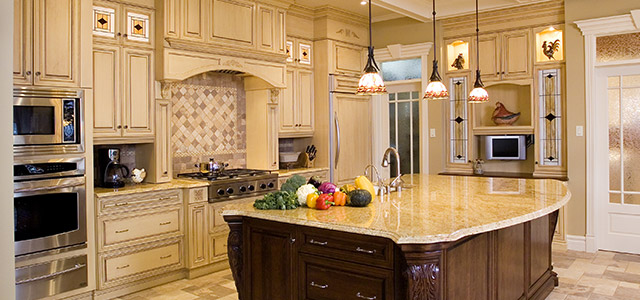Those who know quality understand why granite is regarded as a favorite amongst countertop surfacing options. Durable, stunning and offering up unique and earthy aesthetic qualities, granite countertops provide a long-lasting surface in your home that holds up under daily wear while continuing to look chic while doing it. As a future value investment, nothing says re-sale potential like granite countertops in a home.
For all of these reason and many more, it’s important to understand your options when it comes to granite countertops. While some may assume a countertop is a uniform feature in a home, there are in fact variations on granite that need to be decided between. Granite slabs are a common feature as countertops-particularly in kitchens; however, granite tiles are just as widely used for a number of reasons. The following are some of the primary differences between the two, that might help make a decision when it comes to final installation.
Seamless Qualities
While one is definitely not better than the other, granite tiles and granite slabs offer up different advantages depending on how you use your surfaces in your home. Granite slabs are sourced as one large, seamless piece of stone that is then manufactured into the shape and size your home requires for countertops. As a single piece of stone, a granite slab countertop is going to provide a seamless surface. Similarly, the entirety of the granite surface is going to be the color of your choosing without variation or interrupting seam lines. This approach tends to work well if you have large surfaces to cover and you’re aiming for a streamlined look in your décor.
Granite tiles are sourced in smaller quantities as individual units that are then put together to form a smooth surface in your home. These individual squares are matched with grouting that can be highlighted to create a textured effect on your countertops, or matched to reduce visibility.
Sizing Differences
Depending on the surfacing look you are going for, granite slabs and granite tiles are going to offer up a variety of possibilities. As a single unit to be installed, granite slabs tend to be larger features in your home. Larger slabs of granite can create an ultra-sleek appearance that is easily mixed and matched with other home décor items and accents. In this way, granite slabs become the ultimate foundation for interior design flexibility and durability.
Granite tiles on the other hand, have the potential to be cut into smaller units that can be placed according to need. This can be particularly useful when it comes to working around or installing countertops around difficult to size appliances such as dishwashers and sinks. Along these same lines of versatility, granite tiles tend to come in a few more color options than granite slabs due to their sizing qualities.
Mixing and Matching locations
Installing granite countertops is an art of precision and fit that professionals are trained to handle with ease and grace. That being said, the type of granite surface you choose will impact the type of installation that is required. While it’s recommended that professionals handle granite countertop installation in general, attempts to install granite slabs may be a bit more successful than granite tiles if you’re going at it alone. Granite tiles need to be properly placed and grouted to a smooth finish. This can be difficult if you don’t have the professional experience to back up the intricate work. Similarly, granite slabs can be extremely heavy as a single unit feature, and while they can be installed independently, it’s not recommended.
If you are insisting on trying to install your granite countertops yourself, understanding locations is going to be key to a successful setup. Granite tiles may take more time to install, but they tend to be an easier fit in smaller or harder to access places in your home such as corners or even countertop backsplashes. If you have enough help from family and friends, a granite slab countertop is going to be a more simplified installation process, if not heavier.
Counting the Benefits on Both Sides
While the final appearance may differ slightly, the quality and value of granite slabs and granite tiles couldn’t be found standing on more equal ground. Granite as a stone possesses unsurpassed qualities of beauty, durability and longevity. This natural stone easily maintains it’s coloring and remains fit to withstand the wear and tear of daily life in any home—especially when it’s properly maintained. No matter if you’re looking for a more textured appearance with granite tiles or a smoother, sleek surface with a granite slab—your granite countertop will be well worth the investment. Taking the time to look at how these installation techniques and granite layouts will affect your overall home design is a great step towards ensuring you are pleased with your granite countertops for years to come.


